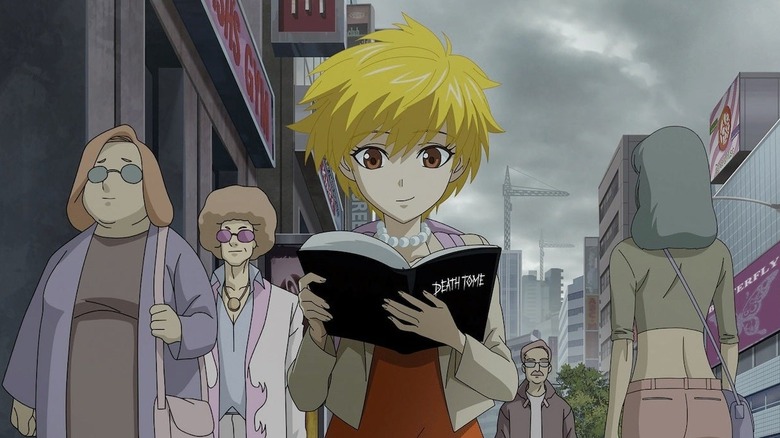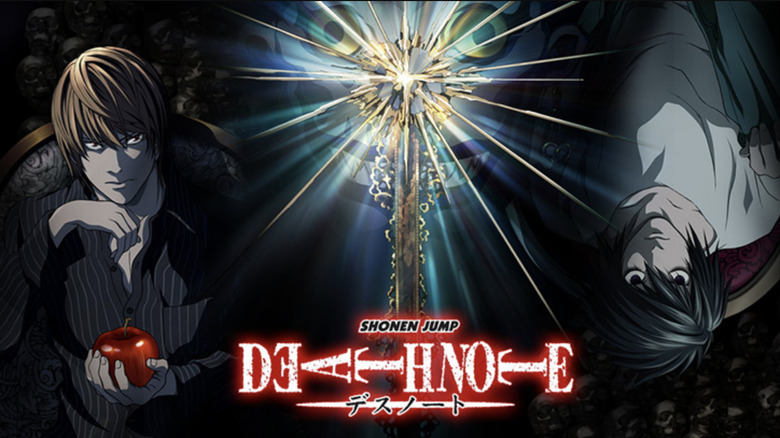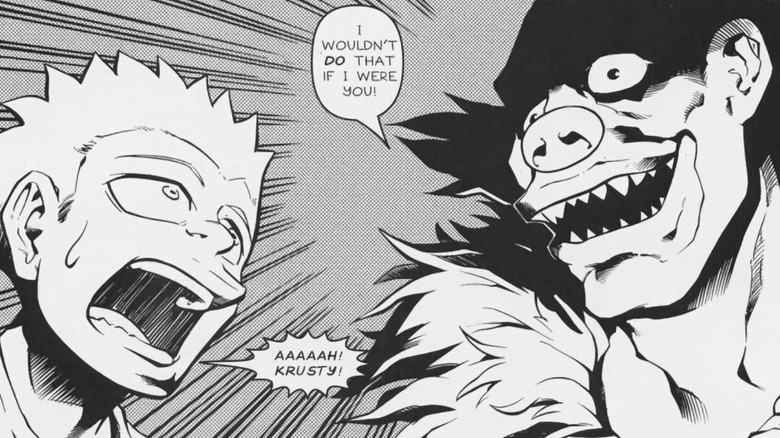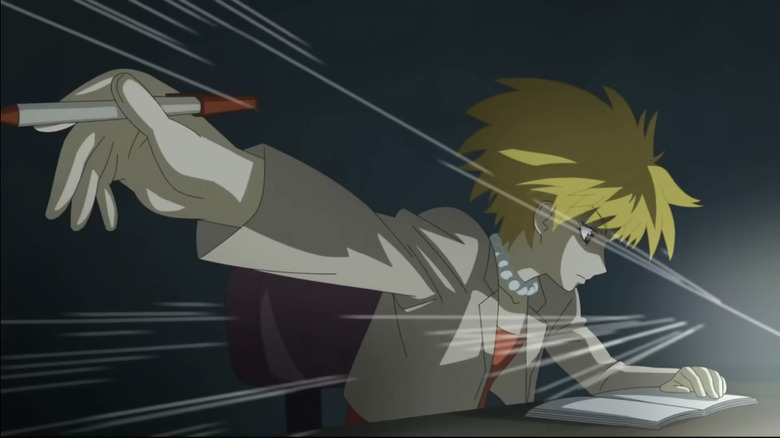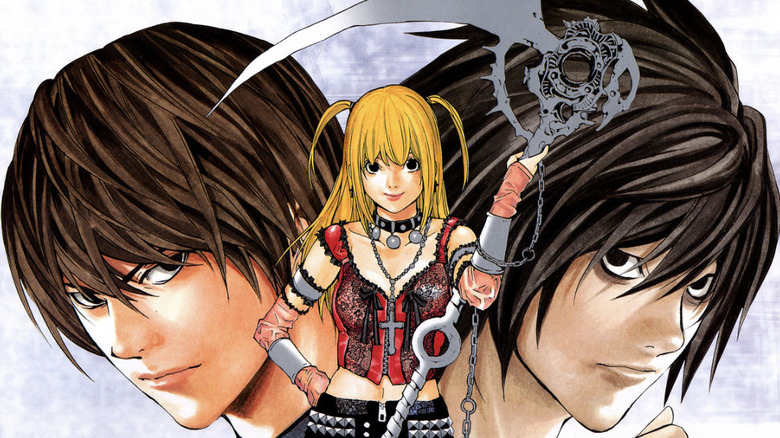This Isn't The First Time The Simpsons Parodied Death Note
"Treehouse of Horror XXXIII," aired on October 30, 2022, turned "The Simpsons" from animation into anime. In the episode's 2nd segment, "Death Tome," Lisa finds a book with the power over life and death, using it to take her environmental activism to new, homicidal levels. If you couldn't tell, the segment is a parody of "Death Note." The episode even renders Springfield and its denizens in anime style, with art supplied by South Korean studio DR Movie, animators of "Death Note" itself.
"Death Note" is one of those go-to anime that even the anime averse have probably heard of. This makes it prime for parody by something as American mainstream as "The Simpsons." In fact, "Death Tome" is not even the first "Treehouse of Horror" parody of the series. However, the first pastiche happened not in "The Simpsons" itself, but a tie-in comic.
What is Death Note?
Before we get to the parodies, what is "Death Note" itself about? Well, it all starts with two very bored people. One is Japanese teenager Light Yagami, who is straight as an arrow and a model student to boot. The other is Ryuk, a Shinigami (Japanese spirits of death). The Shinigami sustain themselves with "Death Notes," books which kill anyone whose name is written on their pages.
One day, Ryuk tosses his Death Note into the human world and Light picks it up. After Light works out the Note's rules and commits a few murders to test it, he decides his new purpose. With the Death Note's power, he'll purge the world of criminals, create a utopia, and reign over it as a god. Ryuk reveals himself and becomes the devil on Light's shoulder. Light's killing get him labeled "Kira," (a Japanese corruption of "Killer"). Soon, he's drawn into a battle of wits with L, an eccentric but brilliant detective out to discover Kira's identity.
The series began as a manga, written by Tsugumi Ohba and drawn by Takeshi Obata. It ran for 108 chapters in Weekly Shonen Jump from 2003 to 2006. Shortly after the manga wrapped, the animation studio Madhouse produced a 37-episode anime, aired from 2006 to 2007. The anime captures the manga's twisty storytelling, resulting in many fine episodes.
The adaptations don't stop there. "Death Note" inspired several live-action movies and a TV series in its native Japan. In 2017, Adam Wingard directed an Americanized version for Netflix. Despite that film's failure, Netflix is gearing up to adapt the series again, this time with the Duffer Brothers' guiding hand.
How do the "Treehouse of Horror" versions compare?
Murder, He Wrote
"Simpsons" comic books, published by Matt Groening's Bongo Comics, supplemented the TV series from 1993 to 2018. The output included an annual "Treehouse of Horror" comic. Twenty-three were published between 1995 and 2017. While no more are forthcoming, they've recently been collected in omnibus edition.
The "Death Note" parody, titled "Murder, He Wrote," appeared in 2008's "Treehouse of Horror" #14. It was written by prolific "Simpsons" comic scribe Ian Boothby with art by Nina Matsumoto and Andrew Pepoy. In this story, Bart finds the Death Note while an undead Krusty stands in for Ryuk. The book's origins are more vague in this story. Krusty was merely the latest owner before he accidentally killed himself by writing an autograph for Bart on the book's paper. Everything also goes back to normal when Lisa discovers another book that can reverse the murders.
What's striking about the comic is how the art mimics Obata's, down to the black and white coloring of manga. According to Matusomoto, there is one "Simpsons" trademark she stuck by: the character's overbites. Even so, the designs are all striking and a good blend of two very different art styles. Bart looks a bit more like the spiky-haired Gon Freecss of "Hunter X Hunter" than Light, but Lisa is dead ringer for L (she shares his posture, eye shadows and taste for sweets). In a twist, it turns out the one investigating Bart isn't Lisa, but Ralph Wiggum (who confused "L" with "R".)
"Murder, He Wrote" won the 2009 Eisner Award for Best Short Story. Could "Death Tome" live up to it?
Death Tome
"Death Tome" proves there's more than one way "The Simpsons" can parody the same story. The most obvious difference? The segment swaps Bart and Lisa's roles compared to "Murder, He Wrote." Instead, Lisa is the Light analogue who finds the Death Note, while Bart is L (as in El Barto). Lisa's Shinigami also isn't an established "Simpsons" character, but a direct Ryuk analogue named Steve Johnson (he is voiced by series regular Hank Azaria though).
As for the aesthetic, the character designs are more traditional anime, as opposed to the hybrid of Groening and Obata that Matsumoto designed. That's not a slight though; the animation is so good I want an entire "Simpsons" anime.
The episode also reinvents the source material in interesting ways. Light stuck with killing criminals, while Lisa targets people like Mr. Burns; rich polluters. "Death Tome" has a more systemic critique than the actual series.
The Death Tome also comes with an additional rule: Lisa can't kill the same way twice. The reason for this change becomes apparent once she embraces her power; the episode has a montage of her sentencing people to death in increasingly ludicrous ways (one victim suffers death by sewer alligator). This parodies the anime's infamous montages. There's only so many ways to make someone writing in a journal look exciting onscreen, so "Death Note" cranked the intensity up to 11 with operatic music, sweeping camera movement, and Light's exaggerated writing motions. The only thing missing is Lisa dramatically eating a potato chip.
The ending also adds another wrinkle to the mythology. Lisa can't kill Bart, so she writes Steve Johnson's name in the Death Tome. When he dies, though, she becomes a Shinigami in his place. This shows what might've happened if Light overcame Ryuk.
Which is better?
It should be clear that "Murder, He Wrote" was primarily a stylistic parody of the original "Death Note" manga, while the anime iteration is chiefly what "Death Tome" spoofs. But which is better?
Compressing a story as complex as "Death Note" into seven minutes and 15 pages isn't easy, but both versions pull it off. Still, I have to give the edge to "Death Tome." In "Murder, He Wrote," the parody is more surface level. The comic had its Easter eggs (Krusty flirts with a dead ringer for Misa Amane), but it felt more taken with the simple concept of a Death Note, not the story itself.
"Death Tome" is a truer parody. The ultimate reflection of this? Lisa as Light and Bart as L better reflects all these characters than the other way around. Now you might be thinking that since Bart's the troublemaker and Lisa's the good one, they should be playing villain and hero, respectively. Think about Light's personality, though. He's a self-righteous genius who's disconnected from his peers and wants to change the world. That much better describes Lisa than Bart. L, likewise, is mostly in it for the fun and enjoys trolling his opponents; so does Bart.
Just because something's been done before doesn't mean it shouldn't be done again.
